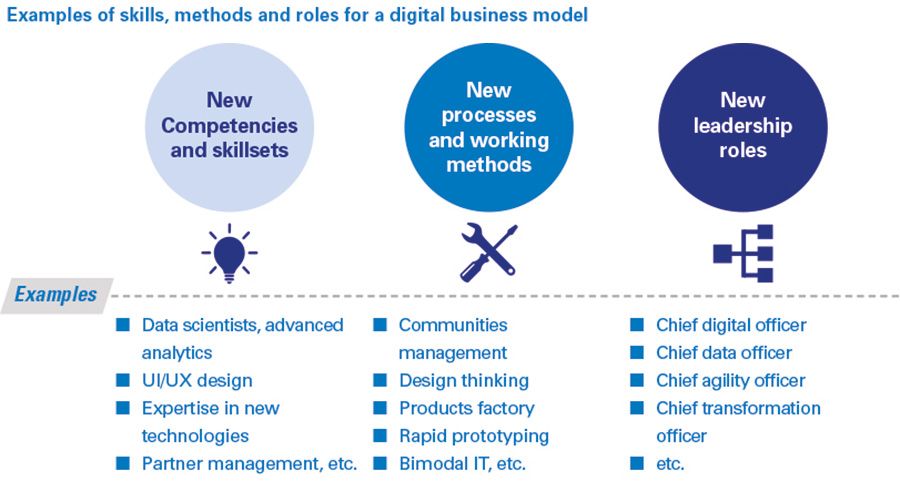- June 18, 2018
- Category: News

Even though digitalisation has become a megatrend across sectors, from manufacturing to local government, there are very few success stories of traditional “analog-native” companies growing enough digitally to compete with “digital natives”. According to the Digital Transformation Study by Arthur D. Little, almost 80% of companies surveyed were only “digitally adaptive” – their digitalisation efforts were limited to products and services at best, and they had no comprehensive approach to digital transformation.
To help organisations move up the maturity scale, experts at management consultancy Arthur D. Little – Jonas Andrén, Lokesh Dadhich, Johan Treutiger and Tove Kjellén – have identified four key questions for organisations to ask themselves when developing digitalisation strategies.
How can we adapt organisational structures to become more digitally mature?
In order to match the agility and customer centricity of digital players, analog-native companies need to break down legacy functional silos. They must create organisations that foster cross-functional collaboration, with processes, such as product development, that flow seamlessly across departments, enabling the digitalisation of products, processes, and touch points in an end-to-end manner. Collaboration needs to stretch outside the organisation to ecosystem partners and customers, as well as internally through the organisational structure.

Organisational models to drive transformation:
The choice of which organisational model to adopt to facilitate digitalisation depends on multiple factors, including current digital maturity, intended target picture, urgency of change and risk aversion.
- Digitally aware organisations embarking on digital transformation may start with central models. This brings clear accountability and transparency at the expense of a possible “us-and-them” relationship with the wider organisation.
- An integrated model overcomes this issue, providing greater momentum for change. However, it risks creating alignment issues due to unclear accountability and the difficulty of following a common vision.
- The hybrid model combines the positives of the central and integrated models, but is more complex and difficult to deliver.
- The most digitally mature structure, the end state for many digital-native companies, is a centrally facilitated and fully integrated model. Here digital is fully embedded in the business model, products and services, processes, and mind-sets of the company.
How can we ensure company-wide digital governance and investments?
Digital-native players leverage the investment and competencies of each component, such as process, product and platform, across the organisation. Successfully replicating this in an analog-native organisation requires strong and robust governance to ensure that the right digital investments are made, shared throughout the organisation to avoid costly duplication, and managed in the best way possible. Another key responsibility of the governance function is to constantly monitor the organisation’s transformation progress, in order to steer the business towards higher levels of maturity – for example, through smart KPIs, which both maintain the business as-is and gradually push it towards digital maturity.
For analog-natives to create truly digital operating models, the IT focus needs to shift from business process management to digital transformation. This shift can be done by going from a situation in which individual business units request IT development and support from the central IT department, to one in which a digitalisation layer can push digital innovation across all group units through a cross-functional team of business and IT experts. This “digitalisation factory” works on top of central IT’s existing infrastructure assets, integrating and implementing digital technologies to enable transformation.

What are the skills, competencies and roles required for a digital business model?
Digital-native organisations rely on new digital competencies, processes and working methods, as well as unique leadership roles in their organisations, in order to deliver the core elements in their DNA, such as customer centricity, agility, data centricity and a culture of continuous experimentation.
On the other hand, analog-native firms typically attract people with specific industry and functional specialisations, and therefore possess gaps in their digital skills and competencies. The success of digitalisation efforts therefore hinge upon their abilities to acquire or develop specific functional competencies around digital skills, technologies and processes (or operating model). It also depends on behavioral competencies that help create the cultural cornerstones necessary for a digital organisation.
Analog-native companies should aim to develop the new leadership roles needed to facilitate digital transformation, along with corresponding changes to their business and operating models. One such commonly considered role is a business-led, market-driven, and application-minded chief digital officer (CDO) to complement the existing chief information officer (CIO) role. The CDO creates new revenue sources and drives digital transformation through high-speed procedures and by leveraging capabilities from across the organisation. The CIO role, on the other hand, is a business-enabling partner, ensuring efficient IT operations and a holistic, efficient IT landscape through business understanding, technology expertise and enforcement of standards.
What cultural shift is required to build a fundamental advantage over digital competitors?
In order for an organisation to digitalise successfully across its layers, it needs to overhaul its corporate culture. Analog companies, which have often succeeded through creating systems and structures to control complicated tasks, generally have cultures that hinder rather than help digital transformation, and the traits that hold back digitalisation need to be identified to move forward. While the technology to enable the digital shift is often already in place, ways of working and thinking within the organisation need to be challenged in order for operational culture to change too.

For analog-native organisations, this shift is normally around areas such as ways of collaborating, employee mobility, and knowledge creation and storage. In digital-native organisations, collaboration is often decentralised (such as through social media), video is frequently used and hierarchies are replaced with cross-functional teams. Employee mobility is enabled through cloud solutions, and the focus is on goal fulfillment rather than process, with knowledge built online through communities and networks.
Conclusion
Analog-native companies face serious challenges in their digitalisation journeys – they are often unaware, sometimes ignorant and most often unprepared for one of the most important battles for their survival. While nurturing their core businesses, analog-native companies need to take a leaf out of the book of digital-native players and make structural changes to their organisational models.
